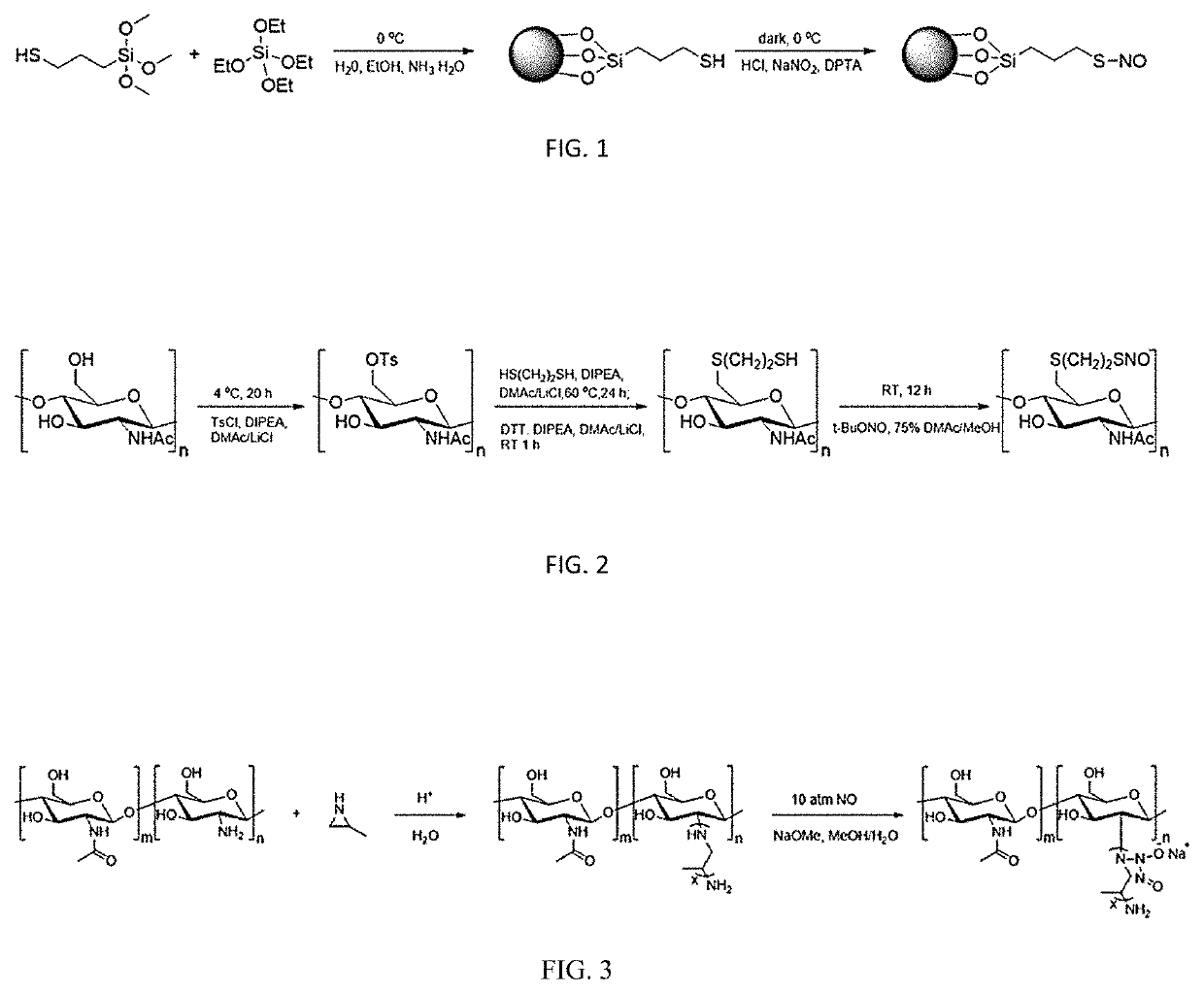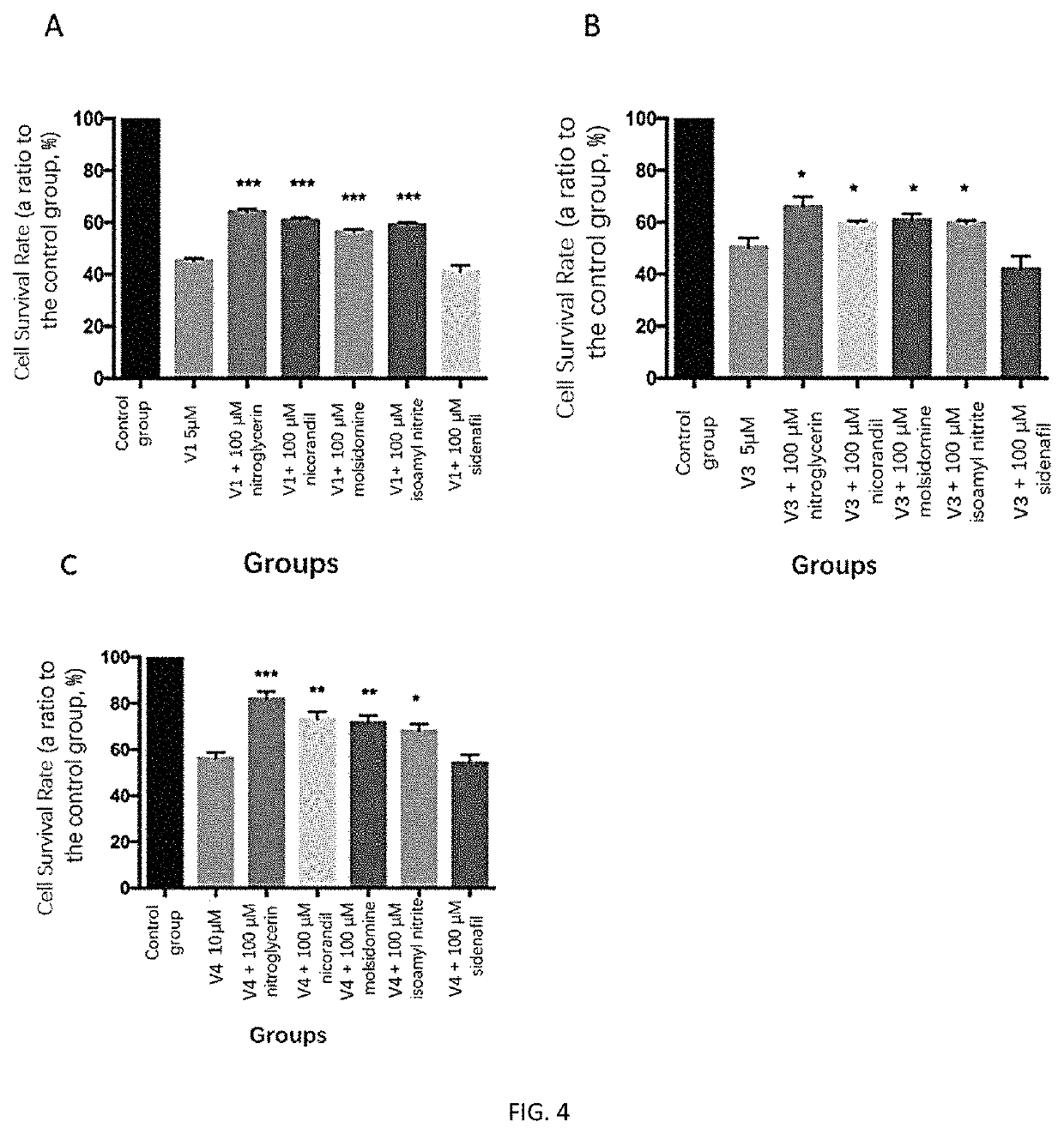Method of preventing or treating side effect of tumor therapy
a tumor therapy and side effect technology, applied in the field of diseases, can solve the problems of adversely affecting the therapeutic effect, accelerating the development of diseases, and serious side effects, and achieve the effect of effectively controlling the side effects
- Summary
- Abstract
- Description
- Claims
- Application Information
AI Technical Summary
Benefits of technology
Problems solved by technology
Method used
Image
Examples
example 1
of S-Nitrosothiol Silica Nanospheres
[0208]A mixed solution of 4 ml of (3-mercaptopropyl) trimethoxysilane and 2 ml of tetraethyl orthosilicate was injected via an injection pump to a mixed solution of 30 ml of deionized water, 30 ml of ethanol and 30 ml of ammonia water at a rate of 0.5 ml / min. During injection, the reaction mixture was kept at 0° C. After completion of injection, the reaction mixture was stirred at room temperature for 2.5 hrs., and then centrifuged at 4000 rpm for 8 min. The precipitates were washed once with 100 ml of ice water and 100 ml of ethanol respectively, and dried under vacuum to give thiolated silica nanospheres.
[0209]150 mg thiolated silica nanosphere was dispersed in 4 ml of methanol, and cooled to 0° C. A mixed solution of 2 ml of 1 M sodium nitrite and 1 mM diethyltriaminepentaacetic acid was added under constant stirring, and then 2 ml of 5 M aqueous solution of hydrochloric acid was added. The reaction mixture was stirred in the dark at 0° C. for ...
example 2
of S-Nitrosoethanedithiol Chitin
[0211]2 g of chitin and 5 g of lithium chloride were dispersed in 50 ml of dimethylacetamide, and 20 ml of N,N-diisopropylethylamine was added at 0° C. 20 g of p-toluenesulfonyl chloride was dissolved in 20 ml of dimethylacetamide, and the resultant mixture was added into the chitin-containing solution as prepared above. The mixed solution was stirred at 4° C. for 20 hrs., and then poured into 300 ml of acetone for precipitation and filtration. The precipitates were washed once with 300 ml of methanol, 150 ml of DI water and 300 ml of acetone respectively, and then dried over under vacuum to give p-tosylated chitin.
[0212]1 g of p-tosylated chitin and 2.5 g of lithium chloride were dispersed into 40 ml of dimethylacetamide, and then 3 ml of N,N-diisopropylethylamine and 1.5 ml of 1,2-ethanedithiol were added. The mixed solution was stirred at 60° C. under nitrogen for 24 hrs, and then poured into 400 ml of acetone for precipitation and filtration. The ...
example 3
of Oligopropylenediamine-Grafted Chitosan NONOate
[0214]250 μL of 2-methylaziridine was mixed with 300 μL of 1 M aqueous solution of hydrochloride, and the mixture was added dropwise into 10 ml of 20 mg / mL chitosan aqueous solution. The mixed solution was stirred at room temperature for 4 days and at 78° C. for 20 hrs, and then poured into 300 ml of acetone for precipitation and centrifugation. The precipitates were washed twice with methanol, and dried over under vacuum to give secondary amine modified chitosan. NMR spectroscopy (by using Bruker Avance III Type NMR spectrometer, 400 MHz, CD3OD) shows peaks at 0.8-1.1, 1.9, 2.3-2.7, 3.3-4.0, and 4.4.
[0215]50 mg secondary amine modified chitosan was dissolved in a mixed solution of 1 mL of water and 3 mL of methanol, and the mixed solution was added into Parr swing hydrogenator, together with 100 μL of 6 M solution of sodium methoxide. The hydrogenator was repeatedly purged with high purity nitrogen to remove oxygen, filled with gaseo...
PUM
| Property | Measurement | Unit |
|---|---|---|
| molecular weight | aaaaa | aaaaa |
| molecular weight | aaaaa | aaaaa |
| molecular weight | aaaaa | aaaaa |
Abstract
Description
Claims
Application Information
 Login to View More
Login to View More - R&D
- Intellectual Property
- Life Sciences
- Materials
- Tech Scout
- Unparalleled Data Quality
- Higher Quality Content
- 60% Fewer Hallucinations
Browse by: Latest US Patents, China's latest patents, Technical Efficacy Thesaurus, Application Domain, Technology Topic, Popular Technical Reports.
© 2025 PatSnap. All rights reserved.Legal|Privacy policy|Modern Slavery Act Transparency Statement|Sitemap|About US| Contact US: help@patsnap.com



